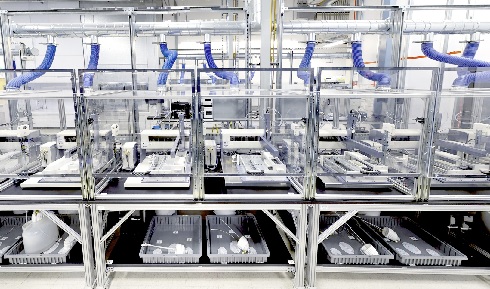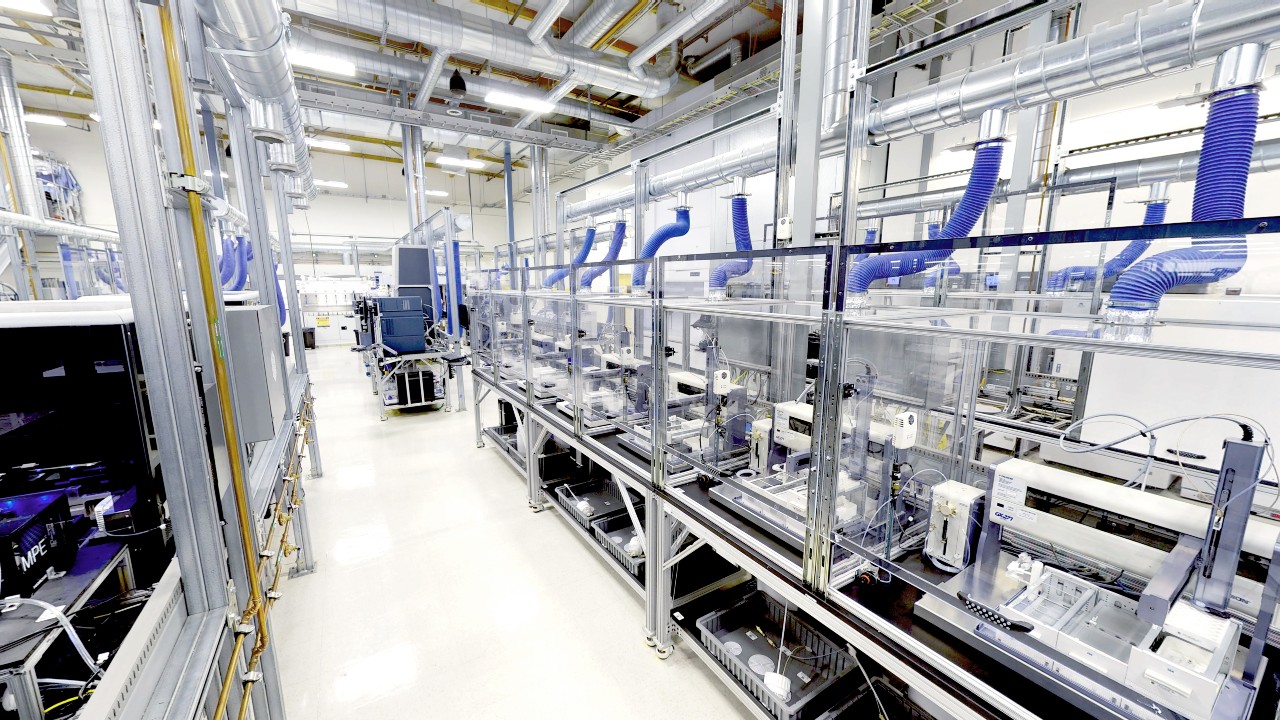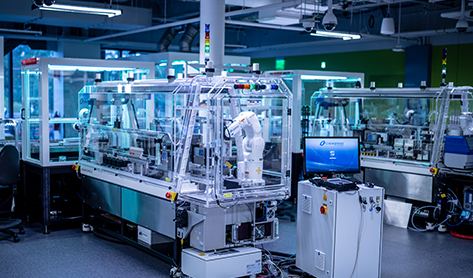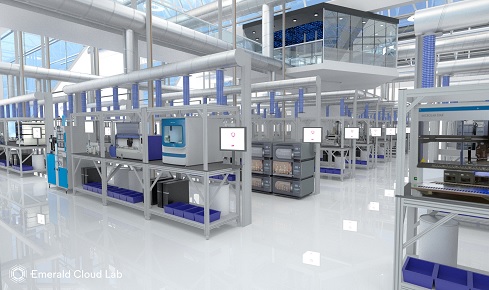What are Cloud Labs?

If you could outsource all your lab work to machines that run 24 hours a day, 365 days a year, would you? Tom Ireland explores how a new generation of remote-operated labs can run your experiments while you sleep – and how they could change what it means to be a scientist
8th August 2022
Cloud labs are highly automated laboratories that allow researchers to design and run experiments remotely, using nothing more than their web browser. With millions of dollars’ worth of top-of-the-range bioscience instruments and inventories linked by sophisticated software, liquid handling robots and magnetic conveyor belts, entire experiments can be programmed to run on their own.
The appeal of these remote-control ‘labs for hire’ became obvious during the early days of the COVID-19 pandemic, when many researchers were desperate to continue generating data when their labs were forced to close. But the founders of cloud labs say that demand for their services is still growing, and that remote, robot-led experimentation is the future of life science.
The labs allow researchers to effectively outsource all aspects of benchwork – from reagent and sample prep to cleaning and maintenance – and run multiple complex workflows concurrently, day and night, seven days a week. Programming the experiments on these systems also turns experimental protocols into unambiguous computer code, which cloud lab operators say reduces human error and improves reproducibility.
An increasing number of start-ups are now using cloud labs to ‘pay and play’ with state-of-the-art equipment they could otherwise not afford; pharmaceutical giants are using them to run vast, automated drug discovery campaigns, and some universities are even using them to teach students.
So how does a cloud lab work, how do you run a remote experiment, and will robot researchers one day replace human scientists at the bench?
What experiments can be done in a Cloud Lab?
The list of instruments and systems that can be operated remotely is diverse and impressive. The Emerald Cloud Lab, based in San Francisco, offers a range of sample preparation, bioassay and structure determination options, workflows for DNA and peptide synthesis, and methods for imaging and detection, and is adding more complex procedures like flow cytometry to its roster. The cloud lab company Strateos has two facilities (also based around the San Francisco region) – one focused on discovering and characterizing novel drug candidates, and the other more geared towards synthetic biology workflows. Meanwhile Arctoris, with facilities in Oxfordshire, Boston and Singapore, offers a remote-operated platform focused mainly on automated, AI-driven drug discovery and testing.
Despite being highly automated, the labs are still staffed by teams of technicians who help with elements of the experiments that robots can’t do and operate instruments that cannot be automated. The labs also have engineers and scientists to help clients get the best out of the instrumentation available.
How does it work?
 Some of the instrumentation at the Emerald Cloud lab in San Francisco.
Some of the instrumentation at the Emerald Cloud lab in San Francisco. How long does it take to set up an experiment?
Emerald say no coding experience is required to operate their browser-based platform, but an initial walk-through and tutorials are required. Its CEO, Brian Frezza, says there is a learning curve of around 10 experiments before novice users feel comfortable and find it easier to programme an experiment than do it themselves in a lab. Strateos, meanwhile, says a researcher using one of their ‘off-the shelf’, i.e. pre-existing workflows could be up and running in a matter of weeks, but to implement more complex bespoke programme of experimentation will require work with their application scientists to get up and running quickly.
How much does it cost?
Cloud labs work with a variety of partners, from small start-ups and academic groups to pharmaceutical giants, and pricing depends on the nature of the relationship and the complexity of the research.
At Emerald, customers buy a subscription that gives them a number of “threads”, or simultaneous processes going on in the lab, a little like paying for bandwidth from an internet provider. ‘Baseline’ capacity (with three 'threads' or simultaneous experimental processes) and costs about $24,000 per month for academic researchers and rises to over $1m a year for an ultra-high capacity service.
Strateos has various pricing models. A simple “fee for service” model is based on the complexity and volume of workflows, for example the number of compounds being screened in a small molecule drug discovery project. (“On average screening ranges from >$100k for smaller libraries to >$500k for large libraries greater than 500,000 molecules,” they say.) They also offer packages that allow greater access and support from pro users and their team of scientists and engineers, and joint ventures between clients and the laboratory.
In an academic rather than industrial setting, it may make more sense to strike an institution-level deal with a cloud lab than for lots of small research groups to use their grants to buy access.
 Automated workcells at one of Strateos' two cloud lab facilities in the San Francisco region.
Automated workcells at one of Strateos' two cloud lab facilities in the San Francisco region. Cloud labs offer the convenience of outsourcing all aspects of lab work, including sample preparation and logistics, instrument maintenance, waste disposal and cleaning, as well as data generation, storage and analysis.
Multiple experiments can be run simultaneously, multiple approaches can be trialled concurrently, and a sequence of experiments can be programmed to run for days on end. Once a successful experimental protocol is converted to cloud lab code, any element of that code can be saved for future use or copied and pasted into other work, saving time on future programming.
Emerald has a range of marketing material that suggest cloud labs can massively improve productivity. The number of samples that can be processed by a single scientist is over three times greater than they would be able to do in person; the time taken to generate data can be reduced from months to weeks or even days, and small R&D operations can save hundreds of thousands of dollars in instrumentation, facilities and staff costs.
What are the pitfalls?
Those who enjoy working at the bench are unlikely to relish the idea of spending yet more of their time on a screen instead. Some scientists have told The Biologist that they worry that remote experimentation would distance them from the sights, sounds and bench-side conversations that inspire new ideas and new directions in their labs; or that important practical skills could be lost if researchers learn to use equipment only remotely. Programming a remote experiment that will be run by machines behind closed doors also leaves little chance for the improvisation and serendipity that can so often lead to new insights in large, busy labs. Others wondered about trusting data that was generated in a warehouse on the other side of the world rather than in their labs by their colleagues.
Biosecurity experts have also express concern about who can access cloud labs, and whether nefarious actors could use them to conduct dangerous or unethical biological experiments without the traditional oversight of an institutional lab. And then there is the cost: many research groups may struggle to fund both an on-site laboratory team and access to a cloud lab.
Where is this headed?
Interest in doing bioscience through cloud labs is growing. Senior scientists at Carnegie Mellon University were so impressed with what they could do with Emerald’s lab in San Francisco during the pandemic that they asked the company to build them their very own one in Pittsburgh. They plan to use it both for research and for teaching. Emerald’s CEO Brian Frezza told The Biologist that he hopes a new generation of students will emerge comfortable with the idea of remote experimentation and excited about its possibilities. “The dean of the university came to me and said, ‘what if we don’t want to just do a few experiments? What would it take to give this technology to everyone at the university – all the students, all the staff, anyone who wants to jump on the system?”
 A mock-up of the Cloud Lab that will be built at Carnegie Mellon University in Pittsburgh.
A mock-up of the Cloud Lab that will be built at Carnegie Mellon University in Pittsburgh. Other bioscience facilities are planning to keep the remote-operating systems that they developed during the pandemic, such as the UK’s Diamond Light Source synchrotron, which has created a browser-based interface that allows its beamlines to be accessed virtually. Although these facilities are not strictly cloud labs, they too are embracing the productivity gains and other benefits of what they call ‘unattended data collection’.
Increasingly, machine learning is being used to drive not just data analysis but the direction and scope of the experimentation itself. And more fundamentally, remote offer an entirely new way of conducting science, where anybody can try and answer a scientific question – even those without the equipment to do it themselves. As Marc Siladi, executive director of commercial operations at Strateos puts it:
“Some of the customers we are attracting are not traditional life science organisations. They're large companies outside of science that want to make contributions to science in an open source manner. And what that speaks to is the ability we have now to extract and contextualise science in such a way that if you have questions to ask and wanted to do science, you don't have to master all of these instruments. And I think that's where this concept and the whole industry is headed.”
Tom Ireland MRSB is editor of The Biologist.


